Text Classification Based on Domain Ontology
classification作文

classification作文英文回答:Classification is the process of categorizing data into different groups or classes based on their attributes. Itis a fundamental task in machine learning and data analysis. There are different types of classification algorithms, including decision trees, logistic regression, supportvector machines, and neural networks.The decision tree algorithm is a popular classification algorithm that works by recursively splitting the data into subsets based on the values of the attributes. The logistic regression algorithm is a statistical method that estimates the probabilities of the outcomes based on the input variables. The support vector machine algorithm is a binary classification algorithm that separates the data into two classes using a hyperplane. The neural network algorithm is a complex algorithm that learns the patterns in the data by adjusting the weights of the connections between theneurons.Classification has many applications in various fields, such as image recognition, speech recognition, fraud detection, and sentiment analysis. For example, in image recognition, a classification algorithm can be trained to recognize different objects in an image, such as cars, buildings, and trees. In speech recognition, aclassification algorithm can be used to identify different words or phrases in a spoken language. In fraud detection, a classification algorithm can be trained to detect fraudulent transactions based on their characteristics. In sentiment analysis, a classification algorithm can be used to classify the sentiment of a piece of text as positive, negative, or neutral.中文回答:分类是将数据根据其属性分为不同的组或类别的过程。
八年级上册英语第二单元ppt课件

Key presence analysis
Identify the key presence of each paragraph
The key presence expresses the paragraph's main idea and commonly appears at the beginning or end of the paragraph
Derivatives
Key vocabulary often has derivative words that can help in understanding the meaning and usage of the root words
Example of vocal application
Domain specific vocabulary
Vocabulary related to a specific subject or domain, such as science, technology, literature, etc
03
General/basic vocabulary
Common words that are widely used in daily life and have a
Read through the exercise carefully, paying attention to details and making notes as necessary
05
Writing training
Writing Skills Tips
Use appropriate language
Example sentences
I watch TV every day He watches football games They watch movies on weekends
基于BERT的短文本相似度判别模型

基于BERT的短文本相似度判别模型方子卿,陈一飞*(南京审计大学信息工程学院,江苏南京211815)摘要:短文本的表示方法和特征提取方法是自然语言处理基础研究的一个重要方向,具有广泛的应用价值。
本文提出了BERT_BLSTM_TCNN模型,该神经网络模型利用BERT的迁移学习,并在词向量编码阶段引入对抗训练方法,训练出包括句的语义和结构特征的且泛化性能更优的句特征,并将这些特征输入BLSTM_TCNN层中进行特征抽取以完成对短文本的语义层面上的相似判定。
在相关数据集上的实验结果表明:与最先进的预训练模型相比,该模型在有着不错的判定准确率的同时还有参数量小易于训练的优点。
关键词:词向量模型;自然语言处理;短文本相似度;卷积神经网络;循环神经网络中图分类号:G642文献标识码:A文章编号:1009-3044(2021)05-0014-05开放科学(资源服务)标识码(OSID):Short Text Similarity Discrimination Model based on BERTFANG Zi-qing,CHEN Yi-fei*(Nanjing Audit University,Nanjing211815,China)Abstract:Short text representation methods and feature extraction methods are an important direction of basic research in natural language processing,and have a wide range of applications.This paper proposes the BERT_BLSTM_TCNN model.The neural net⁃work model uses BERT's transfer learning and introduces an adversarial training method in the word vector encoding stage to train sentence features that include the semantic and structural features of the sentence and have better generalization performance,and combine these The feature is input into the BLSTM_TCNN layer for feature extraction to complete the similarity determination on the semantic level of the short text.The experimental results on the relevant data set show that:compared with the most advanced pre-training model,this model has a good judgment accuracy rate and also has the advantages of small parameters and easy train⁃ing.Key words:word embedding model;natural language processing;short text similarity;convolutional neural networks;recurrent neu⁃ral networks近些年来随着个人计算机的普及和各种网络信息技术的快速进步,数字化的文本数量也随之呈现爆炸式的增长。
classification
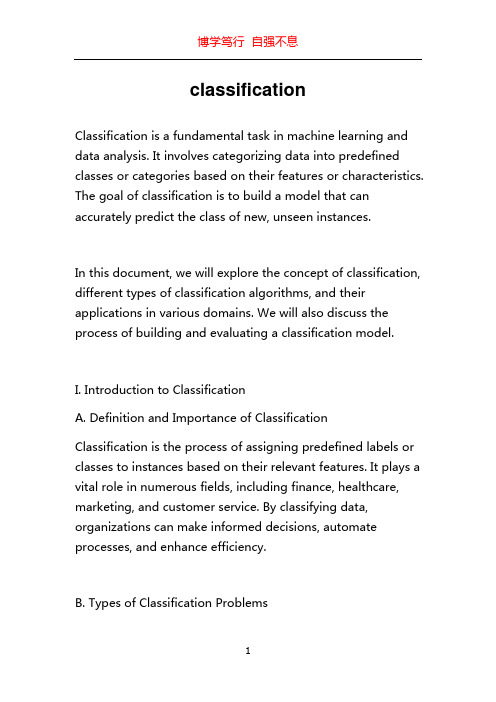
classificationClassification is a fundamental task in machine learning and data analysis. It involves categorizing data into predefined classes or categories based on their features or characteristics. The goal of classification is to build a model that can accurately predict the class of new, unseen instances.In this document, we will explore the concept of classification, different types of classification algorithms, and their applications in various domains. We will also discuss the process of building and evaluating a classification model.I. Introduction to ClassificationA. Definition and Importance of ClassificationClassification is the process of assigning predefined labels or classes to instances based on their relevant features. It plays a vital role in numerous fields, including finance, healthcare, marketing, and customer service. By classifying data, organizations can make informed decisions, automate processes, and enhance efficiency.B. Types of Classification Problems1. Binary Classification: In binary classification, instances are classified into one of two classes. For example, spam detection, fraud detection, and sentiment analysis are binary classification problems.2. Multi-class Classification: In multi-class classification, instances are classified into more than two classes. Examples of multi-class classification problems include document categorization, image recognition, and disease diagnosis.II. Classification AlgorithmsA. Decision TreesDecision trees are widely used for classification tasks. They provide a clear and interpretable way to classify instances by creating a tree-like model. Decision trees use a set of rules based on features to make decisions, leading down different branches until a leaf node (class label) is reached. Some popular decision tree algorithms include C4.5, CART, and Random Forest.B. Naive BayesNaive Bayes is a probabilistic classification algorithm based on Bayes' theorem. It assumes that the features are statistically independent of each other, despite the simplifying assumption, which often doesn't hold in the realworld. Naive Bayes is known for its simplicity and efficiency and works well in text classification and spam filtering.C. Support Vector MachinesSupport Vector Machines (SVMs) are powerful classification algorithms that find the optimal hyperplane in high-dimensional space to separate instances into different classes. SVMs are good at dealing with linear and non-linear classification problems. They have applications in image recognition, hand-written digit recognition, and text categorization.D. K-Nearest Neighbors (KNN)K-Nearest Neighbors is a simple yet effective classification algorithm. It classifies an instance based on its k nearest neighbors in the training set. KNN is a non-parametric algorithm, meaning it does not assume any specific distribution of the data. It has applications in recommendation systems and pattern recognition.E. Artificial Neural Networks (ANN)Artificial Neural Networks are inspired by the biological structure of the human brain. They consist of interconnected nodes (neurons) organized in layers. ANN algorithms, such asMultilayer Perceptron and Convolutional Neural Networks, have achieved remarkable success in various classification tasks, including image recognition, speech recognition, and natural language processing.III. Building a Classification ModelA. Data PreprocessingBefore implementing a classification algorithm, data preprocessing is necessary. This step involves cleaning the data, handling missing values, and encoding categorical variables. It may also include feature scaling and dimensionality reduction techniques like Principal Component Analysis (PCA).B. Training and TestingTo build a classification model, a labeled dataset is divided into a training set and a testing set. The training set is used to fit the model on the data, while the testing set is used to evaluate the performance of the model. Cross-validation techniques like k-fold cross-validation can be used to obtain more accurate estimates of the model's performance.C. Evaluation MetricsSeveral metrics can be used to evaluate the performance of a classification model. Accuracy, precision, recall, and F1-score are commonly used metrics. Additionally, ROC curves and AUC (Area Under Curve) can assess the model's performance across different probability thresholds.IV. Applications of ClassificationA. Spam DetectionClassification algorithms can be used to detect spam emails accurately. By training a model on a dataset of labeled spam and non-spam emails, it can learn to classify incoming emails as either spam or legitimate.B. Fraud DetectionClassification algorithms are essential in fraud detection systems. By analyzing features such as account activity, transaction patterns, and user behavior, a model can identify potentially fraudulent transactions or activities.C. Disease DiagnosisClassification algorithms can assist in disease diagnosis by analyzing patient data, including symptoms, medical history, and test results. By comparing the patient's data againsthistorical data, the model can predict the likelihood of a specific disease.D. Image RecognitionClassification algorithms, particularly deep learning algorithms like Convolutional Neural Networks (CNNs), have revolutionized image recognition tasks. They can accurately identify objects or scenes in images, enabling applications like facial recognition and autonomous driving.V. ConclusionClassification is a vital task in machine learning and data analysis. It enables us to categorize instances into different classes based on their features. By understanding different classification algorithms and their applications, organizations can make better decisions, automate processes, and gain valuable insights from their data.。
Bag of Tricks for Efficient Text Classification

a r X i v :1607.01759v 2 [c s .C L ] 7 J u l 2016Bag of Tricks for Efficient Text ClassificationArmand JoulinEdouard Grave Piotr Bojanowski Tomas MikolovFacebook AI Research{ajoulin,egrave,bojanowski,tmikolov }@AbstractThis paper proposes a simple and efficient ap-proach for text classification and representa-tion learning.Our experiments show that our fast text classifier fastText is often on par with deep learning classifiers in terms of ac-curacy,and many orders of magnitude faster for training and evaluation.We can train fastText on more than one billion words in less than ten minutes using a standard mul-ticore CPU,and classify half a million sen-tences among 312K classes in less than a minute.1IntroductionBuilding good representations for text classi-fication is an important task with many ap-plications,such as web search,information retrieval,ranking and document classifica-tion (Deerwester et al.,1990;Pang and Lee,2008).Recently,models based on neural networks have become increasingly popular for computing sentence representations (Bengio et al.,2003;Collobert and Weston,2008).While these models achieve very good performance in practice (Kim,2014;Zhang and LeCun,2015;Zhang et al.,2015),they tend to be relatively slow both at train and test time,limiting their use on very large datasets.At the same time,simple linear models have also shown impressive performance while being very computationally efficient (Mikolov et al.,2013;Levy et al.,2015).They usually learn word level representations that are later combined to form sen-tence representations.In this work,we propose anextension of these models to directly learn sentence representations.We show that by incorporating additional statistics such as using bag of n-grams,we reduce the gap in accuracy between linear and deep models,while being many orders of magnitude faster.Our work is closely related to stan-dard linear text classifiers (Joachims,1998;McCallum and Nigam,1998;Fan et al.,2008).Similar to Wang and Manning (2012),our moti-vation is to explore simple baselines inspired by models used for learning unsupervised word repre-sentations.As opposed to Le and Mikolov (2014),our approach does not require sophisticated infer-ence at test time,making its learned representations easily reusable on different problems.We evaluate the quality of our model on two different tasks,namely tag prediction and sentiment analysis.2Model architectureA simple and efficient baseline for sentence classification is to represent sentences as bag of words (BoW)and train a linear classifier,for example a logistic regression or support vec-tor machine (Joachims,1998;Fan et al.,2008).However,linear classifiers do not share pa-rameters among features and classes,possibly limiting mon solutions to this problem are to factorize the linear clas-sifier into low rank matrices (Schutze,1992;Mikolov et al.,2013)or to use multilayer neu-ral networks (Collobert and Weston,2008;Zhang et al.,2015).In the case of neural net-works,the information is shared via the hiddenFigure1:Model architecture for fast sentence classification. layers.Figure1shows a simple model with1hidden layer.Thefirst weight matrix can be seen as a look-up table over the words of a sentence.The word representations are averaged into a text rep-resentation,which is in turn fed to a linear classi-fier.This architecture is similar to the cbow model of Mikolov et al.(2013),where the middle word is replaced by a label.The model takes a sequence of words as an input and produces a probability distri-bution over the predefined classes.We use a softmax function to compute these probabilities.Training such model is similar in nature to word2vec,i.e.,we use stochastic gradient descent and backpropagation(Rumelhart et al.,1986)with a linearly decaying learning rate.Our model is trained asynchronously on multiple CPUs.2.1Hierarchical softmaxWhen the number of targets is large,computing the linear classifier is computationally expensive. More precisely,the computational complexity is O(Kd)where K is the number of targets and d the dimension of the hidden layer.In order to im-prove our running time,we use a hierarchical soft-max(Goodman,2001)based on a Huffman cod-ing tree(Mikolov et al.,2013).During training,the computational complexity drops to O(d log2(K)). In this tree,the targets are the leaves.The hierarchical softmax is also advantageous at test time when searching for the most likely class. Each node is associated with a probability that is the probability of the path from the root to that node.If the node is at depth l+1with parents n1,...,n l,its probability isP(n l+1)=li=1P(n i).This means that the probability of a node is always lower than the one of its parent.Exploring the tree with a depthfirst search and tracking the maximum probability among the leaves allows us to discard any branch associated with a smaller probability.In practice,we observe a reduction of the complexity to O(d log2(K))at test time.This approach is further extended to compute the T-top targets at the cost of O(log(T)),using a binary heap.2.2N-gram featuresBag of words is invariant to word order but taking explicitly this order into account is often compu-tationally very expensive.Instead,we use bag of n-gram as additional features to capture some par-tial information about the local word order.This is very efficient in practice while achieving compa-rable results to methods that explicitly use the or-der(Wang and Manning,2012).We maintain a fast and memory efficient mapping of the n-grams by using the hashing trick(Weinberger et al.,2009)with the same hash-ing function as in Mikolov et al.(2011)and10M bins if we only used bigrams,and100M otherwise. 3Experiments3.1Sentiment analysisDatasets and baselines.We employ the same8datasets and evaluation protocol of Zhang et al.(2015).We report the N-grams and TFIDF baselines from Zhang et al.(2015),as well as the character level convolutional model (char-CNN)of Zhang and LeCun(2015)and the very deep convolutional network(VDCNN) of Conneau et al.(2016).We also compare to Tang et al.(2015)following their evaluation protocol.We report their main baselines as well asBoW(Zhang et al.,2015)88.892.996.692.258.068.954.690.4 ngrams(Zhang et al.,2015)92.097.198.695.656.368.554.392.0 ngrams TFIDF(Zhang et al.,2015)92.497.298.795.454.868.552.491.5 char-CNN(Zhang and LeCun,2015)87.295.198.394.762.071.259.594.5 VDCNN(Conneau et al.,2016)91.396.898.795.764.773.463.095.7Table1:Test accuracy[%]on sentiment datasets.FastText has been run with the same parameters for all the datasets.It has10 hidden units and we evaluate it with and without bigrams.For VDCNN and char-CNN,we show the best reported numbers without data augmentation.AG1h3h8h12h2017h3sSogou--8h3013h4018h4036sDBpedia2h5h9h14h5020h8sYelp P.--9h2014h3023h0015sYelp F.--9h4015h1d18sYah.A.8h1d20h1d7h1d17h27sAmz.F.2d5d2d7h3d15h5d20h33sAmz.P.2d5d2d7h3d16h5d20h52sModel Yelp’13Yelp’14Yelp’15IMDBfastText64.266.266.645.2taiyoucon 2011digitals:individuals digital pho-tos from the anime convention taiyoucon 2011in mesa,arizona.if you know the model and/or the character,please comment.#cosplay#24mm #anime #animeconvention #arizona #canon #con #convention #cos #cosplay #costume #mesa #play #taiyou #taiyouconbeagle enjoys the snowfall #snow#2007#beagle #hillsboro #january #maddison #maddy #oregon #snow euclid avenue #newyorkcity#cleveland #euclidavenueModelprec@1Running time Freq.baseline 2.2--Tagspace,h =5030.13h86h Tagspace,h =20035.65h3215hTable 5:Prec@1on the test set for tag prediction onYFCC100M.We also report the training time and test time.Test time is reported for a single thread,while training uses 20threads for both models.Table4shows some qualitative examples.FastText learns to associate words in the caption with their hashtags,e.g.,“christmas”with “#christ-mas”.It also captures simple relations between words,such as “snowfall”and “#snow”.Finally,us-ing bigrams also allows it to capture relations such as “twin cities”and “#minneapolis”.4Discussion and conclusionIn this work,we have developed fastText which extends word2vec to tackle sentence and document classification.Unlike unsupervisedly trained word vectors from word2vec,our word features can be averaged together to form good sentence represen-tations.In several tasks,we have obtained perfor-mance on par with recently proposed methods in-spired by deep learning,while observing a mas-sive speed-up.Although deep neural networks have in theory much higher representational power than shallow models,it is not clear if simple text classifi-cation problems such as sentiment analysis are the right ones to evaluate them.We will publish our code so that the research community can easily build on top of our work.References[Bengio et al.2003]Yoshua Bengio,Rjean Ducharme, Pascal Vincent,and Christian Jauvin.2003.A neu-ral probabilistic language model.JMLR. [Collobert and Weston2008]Ronan Collobert and Jason Weston.2008.A unified architecture for natural lan-guage processing:Deep neural networks with multi-task learning.In ICML.[Conneau et al.2016]Alexis Conneau,Holger Schwenk, Lo¨ıc Barrault,and Yann Lecun.2016.Very deep con-volutional networks for natural language processing.arXiv preprint arXiv:1606.01781.[Deerwester et al.1990]Scott Deerwester,Susan T Du-mais,George W Furnas,Thomas K Landauer,and Richard Harshman.1990.Indexing by latent semantic analysis.Journal of the American society for informa-tion science.[Fan et al.2008]Rong-En Fan,Kai-Wei Chang,Cho-Jui Hsieh,Xiang-Rui Wang,and Chih-Jen Lin.2008.Li-blinear:A library for large linear classification.JMLR. [Goodman2001]Joshua Goodman.2001.Classes for fast maximum entropy training.In ICASSP. [Joachims1998]Thorsten Joachims.1998.Text catego-rization with support vector machines:Learning with many relevant features.Springer.[Kim2014]Yoon Kim.2014.Convolutional neural net-works for sentence classification.In EMNLP.[Le and Mikolov2014]Quoc V Le and Tomas Mikolov.2014.Distributed representations of sentences and documents.arXiv preprint arXiv:1405.4053. [Levy et al.2015]Omer Levy,Yoav Goldberg,and Ido Dagan.2015.Improving distributional similarity with lessons learned from word embeddings.TACL.[McCallum and Nigam1998]Andrew McCallum and Ka-mal Nigam.1998.A comparison of event models for naive bayes text classification.In AAAI workshop on learning for text categorization.[Mikolov et al.2011]Tom´aˇs Mikolov,Anoop Deoras, Daniel Povey,Luk´aˇs Burget,and JanˇCernock`y.2011.Strategies for training large scale neural network lan-guage models.In Workshop on Automatic Speech Recognition and Understanding.IEEE.[Mikolov et al.2013]Tomas Mikolov,Kai Chen,Greg Corrado,and Jeffrey Dean.2013.Efficient estimation of word representations in vector space.arXiv preprint arXiv:1301.3781.[Ni et al.2015]Karl Ni,Roger Pearce,KofiBoakye, Brian Van Essen,Damian Borth,Barry Chen,and Eric rge-scale deep learning on the YFCC100M dataset.In arXiv preprint arXiv:1502.03409.[Pang and Lee2008]Bo Pang and Lillian Lee.2008.Opinion mining and sentiment analysis.Foundations and trends in information retrieval.[Rumelhart et al.1986]David E Rumelhart,Geoffrey E Hinton,and Ronald J Williams.1986.Learning in-ternal representations by error-propagation.In Par-allel Distributed Processing:Explorations in the Mi-crostructure of Cognition.MIT Press.[Schutze1992]Hinrich Schutze.1992.Dimensions of meaning.In Supercomputing.[Tang et al.2015]Duyu Tang,Bing Qin,and Ting Liu.2015.Document modeling with gated recurrent neural network for sentiment classification.In EMNLP. [Wang and Manning2012]Sida Wang and Christopher D Manning.2012.Baselines and bigrams:Simple,good sentiment and topic classification.In ACL. [Weinberger et al.2009]Kilian Weinberger,Anirban Das-gupta,John Langford,Alex Smola,and Josh Atten-berg.2009.Feature hashing for large scale multitask learning.In ICML.[Weston et al.2011]Jason Weston,Samy Bengio,and Nicolas Usunier.2011.Wsabie:Scaling up to large vocabulary image annotation.In IJCAI.[Weston et al.2014]Jason Weston,Sumit Chopra,and Keith Adams.2014.#tagspace:Semantic embed-dings from hashtags.In EMNLP.[Zhang and LeCun2015]Xiang Zhang and Yann LeCun.2015.Text understanding from scratch.arXiv preprint arXiv:1502.01710.[Zhang et al.2015]Xiang Zhang,Junbo Zhao,and Yann LeCun.2015.Character-level convolutional networks for text classification.In NIPS.。
AISSVOL5VOL1-AICIT
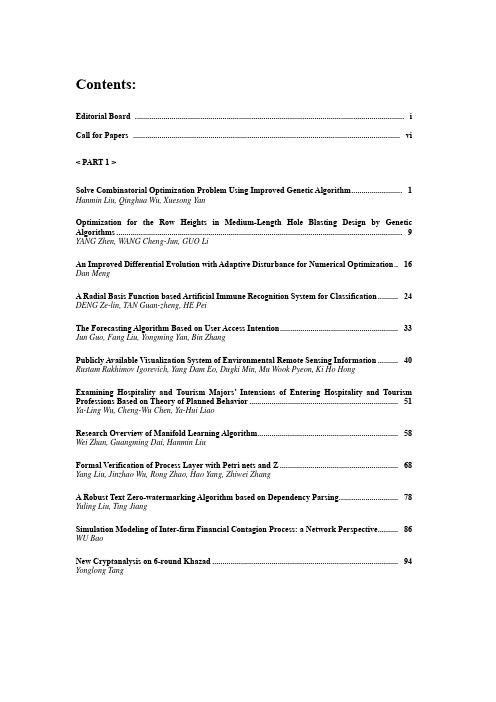
Contents:Editorial Board (i)Call for Papers (vi)< PART 1 >Solve Combinatorial Optimization Problem Using Improved Genetic Algorithm (1)Hanmin Liu, Qinghua Wu, Xuesong YanOptimization for the Row Heights in Medium-Length Hole Blasting Design by Genetic Algorithms (9)YANG Zhen, WANG Cheng-Jun, GUO LiAn Improved Differential Evolution with Adaptive Disturbance for Numerical Optimization .. 16 Dan MengA Radial Basis Function based Artificial Immune Recognition System for Classification (24)DENG Ze-lin, TAN Guan-zheng, HE PeiThe Forecasting Algorithm Based on User Access Intention (33)Jun Guo, Fang Liu, Yongming Yan, Bin ZhangPublicly Available Visualization System of Environmental Remote Sensing Information (40)Rustam Rakhimov Igorevich, Yang Dam Eo, Dugki Min, Mu Wook Pyeon, Ki Ho HongExamining Hospitality and Tourism Majors’ Intensions of Entering Hospitality and Tourism Professions Based on Theory of Planned Behavior (51)Ya-Ling Wu, Cheng-Wu Chen, Ya-Hui LiaoResearch Overview of Manifold Learning Algorithm (58)Wei Zhan, Guangming Dai, Hanmin LiuFormal Verification of Process Layer with Petri nets and Z (68)Yang Liu, Jinzhao Wu, Rong Zhao, Hao Yang, Zhiwei ZhangA Robust Text Zero-watermarking Algorithm based on Dependency Parsing (78)Yuling Liu, Ting JiangSimulation Modeling of Inter-firm Financial Contagion Process: a Network Perspective (86)WU BaoNew Cryptanalysis on 6-round Khazad (94)Yonglong TangA New Risk Assess Model for Urban Rail Transit Projects (104)Zhu Xiangdong, Xiao Xiang, Wu ChaoranAnt Colony Algorithm Optimized by Vaccination (111)He Haitao, Xin NingComputer Network Security and Precaution Evaluation based on Incremental Relevance Vector Machine Algorithm and ACO (120)Guangyuan SongRealization of an Embedded and Automated Performance Testing System for a MEMS Transducer (128)LIAO Hai-yang, XIONG Kui, WEN Zhi-yuMulti-level Cache Prediction and Partitioning Mechanism in CMP (135)Shuo Li, Gaochao Xu, Xiaozhong Geng, Xiaolin Qiao, Feng WuNew Classes of Sequences for Encryption Procedures in Symmetric Cryptography (145)Amparo Fuster-SabaterExplore and Analysis of Environmental Policy Based on Green Industry Development (152)Chunhong Zhu, Zhe Liu, Yue Zhou, Xuehua ZhangResearch on Service Encapsulation of Manufacturing Resources Based on SOOA (158)Lingjun Kong, Wensheng Xu, Nan Li, Jianzhong ChaA Twice Ant Colony Algorithm Based on Simulated Annealing for Solving Multi-constraints QoS Unicast Routing (167)Yongteng Lv, Yongshan Liu, Wei Chen, Xuehui Shang, Yuanyuan Han, Chang LiuA Two-phase Multi-Constraint Web Service Selection Approach for Web Service Composition (176)Zhongjun Liang, Hua Zou, Fangchun Yang, Rongheng LinAdvanced Coupled Map Lattice Model for the Cascading Failure on Urban Street Network . 186 ZHENG Li, SONG Rui, Xiao YunTransition Probability Matrix Based Tourists Flow Prediction (194)Yuting Hu, Rong Xie, Wenjun ZhangA Study on the Macro-Control Policy of China Real Estate Development (202)Lu ShiAn Effective Construction of a Class of Hyper-Bent Functions (212)Yu Lou, Feng Zhou, Chunming TangSpeaker-independent Recognition by Using Mel Frequency Cepstrum Coefficient and Multi-dimensional Space Bionic Pattern Recognition (221)Guanglin Xian, Guangming XianIntelligent Decision Support System (IDSS) for Cooling/Heating Sources Scheme Selection of City Buildings Based on AHP Method (228)Liu Ying, Jiang Kun, Jiang ShaModeling of Underwater Distributed Target Based on FDTD and Its Scale Characteristic Extraction (237)P AN Yu-Cheng, SHAO Jie, ZHAO Wei-Song, ZHONG Ya-QinMethod for Dynamic Multiple Attribute Decision Making under Interval Uncertainty and its Application to Supplier Selection (246)Xu JingStudy on Multi-Agent Information Retrieval Based on Concern Domain (254)Sun JianmingA New Method for Solving Numerical Solution of Fractional Differential Equations (263)Jianping Liu, Xia Li, HuiQuan Ma, XueZhi Mao Guoping ZhenAssessment and Analysis of Hierarchical and Progressive Bilingual English Education Based on Neuro-Fuzzy approach (269)Hao Xin< PART 2 >Computer-based Case Simulations in China: 2001-2011 (277)Tianming Zuo, Peng Wang, Baozhi Sun, Jin Shi, Yang Zhang, Hongran BiHybrid Monte Carlo Sampling Implementation of Bayesian Support Vector Machine (284)Zhou Yatong, Li Jin, Liu LongA Face Recognition Method based on PCA and GEP (291)WANG Xue-guang, CHEN Shu-hongResearch and Application of Higher Vocational College Library Personalized Information Service Based on Cloud Computing (298)Meiying Nie, XinJuan Zhou,Qingzhi WenA Calculation Model for the Rover’s Coverage Boundary on the Lunar Surface Based on Elevation (307)Hu Yasi, Meng Xin, Pan Zhongshi, Li Dalin, Liang Junmin, Yang YiAn Evaluation of firms’ Best Strategies with the ANP, AHP and Sensitivity Test Approaches 316 Catherine W. Kuo, Shun-Chiao ChangDesign of Embedded Vehicle Safety Monitoring System (326)Jing-Lian, Lin-Hui Li, Hu-Han, Ya-Fu Zhou, Feng-Hu, Ze-Quan ZengThe Approach to Obtain the Accurate TOA of VHF Lightning Signals Based on FastICA Algorithm (334)Xuquan Chen, Wenguang ZhaoIntegrating Augmented Reality into Consumer’ Tattoo Try-on Experience (341)Wen-Cheng Wang, Hao-Hsiang Ku, Yen-Wu TiResearch on Location for Emergency Logistics Center Based on Node Cost (348)Wang ShouqiangLogistics Terminal Facility Location Model Based on Customer Value in Competitive Environment (354)Han Shuang Wang XiaoxiaA Decision Support Model for Risk Analysis with Interval-valued Intuitionistic Fuzzy Information (362)Guoqing WuPeak to Average Power Ratio Reduction with Bacterial Foraging Algorithm for OFDM Systems (370)Jing Gao, Jinkuan Wang, Bin WangUsing Linear and Nonlinear Inversion Algorithm Combined with Simple Dislocation Model Inversion of Coal Mine Subsidence Mechanism (379)Yu-Feng ZHU,Qin-Wei WU,Tie-Ding Lu, Yan LuoApplication of Multi- media in Education of Schoolgirl’s Public P. E. in College and University—set Popular Aerobics as Example (388)Yuanchao zhouA Fuzzy Control System for Trailers Driven by Multiple Motors in Side Slipway to Launch and Pull Out Ships (395)Nyan Win Aung, Wei HaijunA Novel Image Encryption Algorithm based on Virtual Optical Imaging and Hyper-chaos .. 403 Wei Zhu , Geng Yang, Lei Chen, Zheng-Yu ChenThe Structure Character of Market Sale Price in the Coordinating Supply Chain (412)Jun Tian, Zhichao WangDesign Parameter Analysis for Inducers (419)Wei Li, Weidong Shi, Zhongyong Pan, Xiaoping Jiang, Ling ZhouAutomatic Recognition of Chinese Traffic Police Gesture Based on Max-Covering Scheme .. 428 Fan Guo, Jin Tang, Zixing CaiDetermination of Acrylamide Contents in Fried Potato Chips Based on Colour Measurement 437 Peng He, Xiao-Qing Wan, Zhen zhou, Cheng-Lin WangAn Efficient Method of Secure Startup and Recovery for Linux (446)Lili Wu, Jingchao Liu,Research on Life Signals Detection Based on Parallel Filter Bank and Higher Order Statistics (454)Jian-Jun LiResearch for Enterprise Logistics Dynamic Optimization Based on the Condition of Production Ability Limited (462)Guo QiangTechnological Progress in Macroeconomic Volatility and Employment Impact analysis - Based on Endogenous Labor RBC Model (469)Wang Qine, Hu honghaiResearch on Bottleneck Identification in Multiple Products Small lot Production Logistics of Manufacturing Enterprise Based on TOC (476)Jian Xu, Hongbo WangThe Spiral Driven and Control Method Research of the Pipe Cleaning Robot (484)Quanyu Yu, Jingyuan Yu, Jun Wang, Jie LiuHoisting Equipment of Coal mine Condition Monitoring and Early Warning Based on BP Neural Network (491)Shu-Fang Zhao, Li-Chao ChenSpatial Temporal Index-based Historic Closing Event Query or Moving Objects (497)Xianbiao Ji, Hong Mi, Zheping ShaoResearch on the Risk-sharing Mechanism of Energy Management Contract Project in Building Sector (510)CaiWeiguang, Ren Hong, Qin BeibeiFinancial Crisis and Financial Index Structure Break (516)Keng-Hsin Lo, Yen-Chang Chen, Yi -Wei ChuangThe Research of Cooling System for the High-Energy Storage Flywheel (522)Wang Wan, He LinNumerical Models and Seismic Design of Steel Frames Equipped with Supplemental Fluid Viscous Devices (528)Marco ValenteStudy on Positive and Dynamic Enterprise Crisis Management based on Sustainable Business Model Innovation (535)Shi-chang Fu, Hui-fen Wang, Dalen ChiangQuantitatively Study on the Mechanism of Cooperating Profit Distribution within Business Ecosystem (544)Bin HuStudy on the Landscape Design of Urban Commemorative Squares Based on Sustainable Development (552)Wenting Wu, Ying Li, Yi Ren< PART 3 >SRPMS: A web-based Project Management System for Scientific Research (559)Yanbao Ji, Xiaopeng Yun, Zhao Jun, Quanjiang Bai, Lingwang GaoEmpirical Study on Influence Factors of Carbon Dioxide Emissions in Liaoning Province based on PLS (567)Yu-xi Jiang, Su-yan He, Xiang-chao WeiHarmony Factor Considered Evaluation of Science Popularization Talents Based on Grey Relational Analysis Model (575)Li MingStudy on the Safety of High-Speed Trains under Crosswind (582)Xian-Liang Sun, Bin-Jie Wang, Ming Gong, San-San Ding, Ai-Qing TianControl Method of Giant Magnetostrictive Precise Actuator Based on the Preisach Hysteresis Theory (589)Yu Zhang, Huifang Liu, Feng SunDynamic Modeling and Characteristics Analysis of Rolls along Axial Direction for Four High Mill Based on Timoshenko Theory (602)Jian-Liang Sun, Yan PengConstruct on Maintenance Requirement Analysis Model of Pavement Management System 610 Xiu-shan Wang, Yun-fang YangAutomatically Generate Test Data Based on Intelligent Algorithms Method (617)Jian Ni, Ning-NingYangAnalysis of the Functions of a High-Speed Railway Station in China (623)Li-Juan Wang, Tian-Wei Zhang, Fan Wang, Qing-Dong ZhouEconometric Analysis of Expectation in Savings-to-Investment in Capital Market Converting Process (630)Wang Yantao , Yu Lihua ,Mao BeibeiAnalysis Model and Empirical Research on Product Innovation Process of Manufacturing Enterprises Based on Entropy-Topsis Method (637)Hang Yin, Bai-Zhou Li, Tao Guo, Jian-Xin ZhuThe Market Analysis and Prediction of Chinese Iron and Steel Industry (645)Li Xiaohan, Sun Qiubai , Li HuaSystem Dynamics Mode Construction and System Simulation in the Product Innovation Process (653)Jian-Xin Zhu, Jun DuResearch on Organization Innovation of Enterprise Based on Complexity Theory (664)Yu Zheng, Tao GuoThe Study on TFP of Iron and Steel Industry inChina Based on DEA-Malmquist Productivity Index Model (672)Xiaodong Dong, Yuzhi ShenResearch and Implementation of Energy Balance Control System in Metallurgy Industry (681)Qiu DongA Study of Opportunities and Threats in the Implementation of International Marketing for Production Design of Corporate Brand Licensing – A Case Study of POP 3D Co., Ltd. (689)Min-Wei Hsu,Tsai-Yun Lo,Liang,K.C.Research on Risk Forming Mechanism and Comprehensive Evaluation of the Enterprise Group (695)Dayong XUMode Construction of Dining Reform in Universities Based on Theory of Institutional Transformation (704)Li PingjinResearch on QR Decomposition and Algorithm of Linguistic Judgment Matrix (711)Lu YuanA Comparison of the Mahalanobis-Taguchi System to A Selective Naïve Bayesian Algorithm for Semiconductor Chemical Vapor Deposition Process (720)Jui-Chin Jiang, Tai-Ying LinStudy of Policy-making Model for Producer Service: Empirical Research in Harbin (730)Xin Xu, Yunlong DingKrein space H∞ filtering for initial alignment of SINS with large azimuth misalignment (738)Jin Feng, Fei Yu, 3Meikui Zou, Heming JiaInternet Word-Of-Mouth on Consumer Online Purchasing Behavior Analysis in China (747)Jie Gao, Weiling YeConvex Relaxation for Array Gain/Phase Calibration in ULAs and UCAs with Unknown Mutual Coupling (758)Shu CaiFinancial-Industrial Integration Risk Management Model of Listed Companies Base on Logistic (767)Ke WenBehavior Equilibrium Analysis for The Cross-Organizational Business Process Reengineering in Supply Chain (775)Jianfeng Li, Yan ChenA Secure Scheme with Precoding Approach in Wireless Sensor Networks (782)Bin Wang, Xiao Wang, Wangmei GuoA New Method on Fault Line Detection for Distribution Network (789)Bo LiManagers’ Power and Earnings Manipulating Preference (796)J. Sun, X. F. Ju, Y. M. Peng, Y. ChangStudy and Application of the Consistency of Distributed Heterogeneous Database Based on Mobile Agent (804)Zhongchun Fang, Hairong Li, Xuyan Tu。
基于专家系统的Φ-OTDR模式识别方法研究
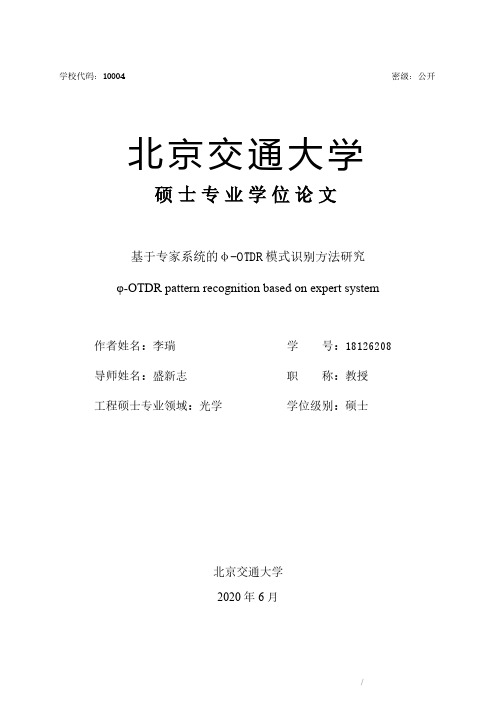
分布式光纤传感技术对比 ............................................................................................. 2
data.
(5) An expert system classification structure based on the model is proposed. Three sub
classifiers and the model are trained and adjusted through 5 fold cross validation. The average
2020 年 6 月
致谢
本论文的工作是在我的导师盛新志教授的悉心指导下完成的。盛新志教授严谨的
治学态度和科学的工作方法给了我极大的帮助和深远的影响。盛新志教授在学习和课
题研究工作中也给予了我很大的帮助,在此由衷地感谢盛新志教授在两年中对我的关
心与指导,表示我由衷的谢意。
梁生老师对我的科研工作提出了宝贵的意见,在此表示衷心的感谢。
目
录
中文摘要 ........................................................................................................................................................ iii
ABSTRACT ................................................................................................................................................... iv
基于领域相关词汇提取的特征选择方法
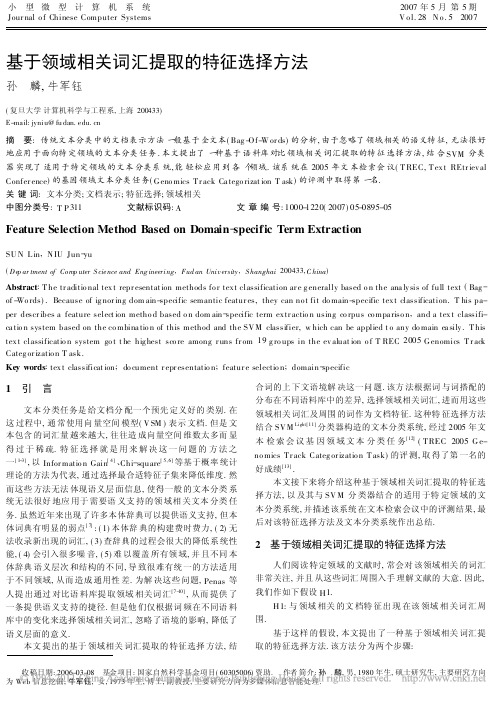
收稿日期:2006-03-08 基金项目:国家自然科学基金项目(60305006)资助. 作者简介:孙 麟,男,1980年生,硕士研究生,主要研究方向为Web 信息挖掘;牛军钰,女,1973年生,博士,副教授,主要研究方向为多媒体信息智能处理.基于领域相关词汇提取的特征选择方法孙 麟,牛军钰(复旦大学计算机科学与工程系,上海200433)E-mail:jyniu@fu 摘 要:传统文本分类中的文档表示方法一般基于全文本(Bag -O f-W or ds)的分析,由于忽略了领域相关的语义特征,无法很好地应用于面向特定领域的文本分类任务.本文提出了一种基于语料库对比领域相关词汇提取的特征选择方法,结合SVM 分类器实现了适用于特定领域的文本分类系统,能轻松应用到各个领域.该系统在2005年文本检索会议(T REC,T ex t REtr iev al Confer ence )的基因领域文本分类任务(G eno mics T r ack Ca tego rizat ion T ask )的评测中取得第一名.关键词:文本分类;文档表示;特征选择;领域相关中图分类号:T P 311 文献标识码:A 文章编号:1000-1220(2007)05-0895-05Feature Selection Method Based on Domain -specific Term ExtractionSU N L in ,N IU Jun -yu(De p ar tment of Comp uter S cie nce and Eng ineering ,Fud an Univ ersity ,S hanghai 200433,C hina )Abstract :T he tr aditio nal tex t repr esentat ion methods fo r tex t classification ar e g enerally based o n the ana ly sis of full text (Bag -of -Wo rds).Because of ig nor ing dom ain-specific semantic featur es,they can no t fit do main-specific tex t classification.T his pa-per descr ibes a feature select ion metho d based o n dom ain -specific term ex tr actio n using co rpus co mpa riso n ,and a tex t classifi-ca tio n system based on the co mbina tio n of this method and the SV M classifier,w hich can be applied t o any do main ea sily.T his tex t classificatio n system go t t he hig hest sco re among r uns fr om 19g ro ups in the ev aluat ion o f T REC 2005G enomics T r ack Categ or izatio n T ask.Key words :tex t classificat ion ;do cument r epr esentatio n ;featur e selectio n ;domain -specific1 引 言文本分类任务是给文档分配一个预先定义好的类别.在这过程中,通常使用向量空间模型(V SM )表示文档.但是文本包含的词汇量越来越大,往往造成向量空间维数太多而显得过于稀疏.特征选择就是用来解决这一问题的方法之一[1-3],以Infor matio n Gain [4]、Chi -square [5,6]等基于概率统计理论的方法为代表,通过选择最合适特征子集来降低维度.然而这些方法无法体现语义层面信息,使得一般的文本分类系统无法很好地应用于需要语义支持的领域相关文本分类任务.虽然近年来出现了许多本体辞典可以提供语义支持,但本体词典有明显的弱点[7]:(1)本体辞典的构建费时费力,(2)无法收录新出现的词汇,(3)查辞典的过程会很大的降低系统性能,(4)会引入很多噪音,(5)难以覆盖所有领域,并且不同本体辞典语义层次和结构的不同,导致很难有统一的方法适用于不同领域,从而造成通用性差.为解决这些问题,Penas 等人提出通过对比语料库提取领域相关词汇[7-10],从而提供了一条提供语义支持的捷径.但是他们仅根据词频在不同语料库中的变化来选择领域相关词汇,忽略了语境的影响,降低了语义层面的意义.本文提出的基于领域相关词汇提取的特征选择方法,结合词的上下文语境解决这一问题.该方法根据词与词搭配的分布在不同语料库中的差异,选择领域相关词汇,进而用这些领域相关词汇及周围的词作为文档特征.这种特征选择方法结合SV M Light[11]分类器构造的文本分类系统,经过2005年文本检索会议基因领域文本分类任务[12](T REC 2005G e-no mics T r ack Categ or izatio n T ask)的评测,取得了第一名的好成绩[13].本文接下来将介绍这种基于领域相关词汇提取的特征选择方法,以及其与SV M 分类器结合的适用于特定领域的文本分类系统,并描述该系统在文本检索会议中的评测结果,最后对该特征选择方法及文本分类系统作出总结.2 基于领域相关词汇提取的特征选择方法人们阅读特定领域的文献时,常会对该领域相关的词汇非常关注,并且从这些词汇周围入手理解文献的大意.因此,我们作如下假设H 1.H1:与领域相关的文档特征出现在该领域相关词汇周围.基于这样的假设,本文提出了一种基于领域相关词汇提取的特征选择方法.该方法分为两个步骤:小型微型计算机系统Jour nal o f Chinese Computer Systems 2007年5月第5期V o l.28N o.52007 (1)通过对比语料库找出领域相关词汇.(2)以这些词汇为中心,选择其周围一定数量的词作为文档特征.2.1 基于语料库对比的领域相关词汇提取方法基于语料库对比的领域相关词汇提取方法的基本思想是,通过对比词的某种属性在某个特定领域的语料库以及包含很广泛领域的一般语料库中的差异,选择出这个特定领域语料库中与其领域相关的词汇.因此,首先要选择一个属于某特定领域的语料库作为领域相关词汇提取的研究对象A C (Analysis Co rpus),以及一个包含很广泛领域的语料库作为参照RC (Refer ence Cor pus ).然后,为每个出现在A C 中的词对比它的某些属性在这两个语料库中的差异,根据这种差异选择出A C 中与该特定领域相关的词汇.传统的基于语料库对比的领域相关词汇提取方法[7-10]主要是通过对比词的词频在不同语料库中的差异来选择领域相关词汇.以Penas 等人[7]为代表,他们通过对比词的词频在特定领域的语料库与一般领域的语料库中的差异,选择在特定领域的语料库中的领域相关词汇.然而这些方法均忽略了词的上下文语境.一般来讲,领域相关词汇不仅在词频方面存在差异,而且这种词汇在不同领域中所搭配的词通常会有很大的变化.如“disk ”若出现在餐饮领域,通常会与“china ”、“washer ”等词搭配形成“china disk ”、“disk washer "等二元词组;然而若在计算机领域,“disk "则通常与“har d ”、“dr iver "等词搭配形成“har d disk"、“disk dr iv er "等二元词组.因此,我们做如下假设H2.H2:某个词与其他词搭配的概率分布在不同领域中变化越大,则说明这个词与该领域越相关.对于那些只出现在A C 或RC 中的词,由于其缺乏可比性,因此不属于此算法研究对象.对于每个同时出现在AC 和RC 中的词ter m i ,若在A C 和R C 中总共有m i 个不同的词ter m j 连接在term i 后面,如图1所示,可以为ter m i 构造m i 维的Bi -gr am 向量空间模型,用来描述ter m i 在A C 、RC 中与这m i 个词的连接分布.图1 term i 在A C 和RC 中的Bi-gr am 向量VA 和VR F ig.1T he Bi-g ra m vecto r V A and V R o f ter m i in A C and RC V A 、V R 是两个m i 维向量,分别描述ter m i 在A C 、RC 中与这m i 个词的搭配分布,称之为Bi -g r am 向量.Bi -g ra m 向量的每个分量表示以ter m i 开头ter m j (j =1,2,…,m i )结尾的Bi -gr am 词组在相应语料库中出现的次数(phr ase fr equency),用p f ij A 表示该词组在A C 中出现的次数,用p f ij R 表示该词组在RC 中出现的次数.若该词组未在某个语料库中出现,则在对应于这个语料库的向量的相应的分量上的值为0.基于这个向量空间模型,我们可以构造一个用于计算term i 在AC 所属的领域中的特殊性(Speciality i )公式F 1. F1:Sp eciality i =S Ai S Ri S A i=∑m ij =1pf A ij tf R i -1m iS R i=∑m ij =1pf R ijtf A i -1m iF1:计算ter m i 在AC 所属的领域中的特殊性(Speciali-t y i )的公式Sp eciality i 表示t erm i 在AC 所属的领域中的特殊性,tf i A 为term i 在AC 中的词频,tf i R为ter m i 在RC 中的词频,m i =0的词被忽略了,S i R =0且S i A ≠0的词的Speciality i设为-1.根据公式F 1,Speciality 分数高的词被选出来作为AC 的领域相关词汇.表1列出了根据此公式得出的Specialit y 分数最高的词语,这些词经过了Po rt er Stemmer 的取词干的处理.表1 按照Speciality 分数排列,得分最高的20个词T able 1T he 20to p -ranked w o rds acco rdingto the sco re o f specialityNo TermNo T erm 1phosph or yl 11upregul 2overex pres s 12term inu 3tyros in 13his ton4isofor m 14su bcellu lar 5exon 15stain 6cleavag 16endoth 7down regul 17cytos ol 8plasmid 18repres s9fulllength 19transmembran 10fibr ob last20bead2.2 基于领域相关词汇提取的文档特征选择基于假设H1,领域相关词汇周围一般存在着与文档及该领域密切相关的特征.而远离这些词汇的词语、语句、甚至段落谈论与领域相关话题的可能性较小.因此,在得到语料库中的领域相关词汇之后,则选取这些词汇为中心一定长度的窗口内的词作为文档特征.根据选择领域相关词汇的多少以及窗口的大小,可以产生不同的特征集.若这些词汇太多或者窗口长度太大,则有可能包含了文档内大部分或全部内容;若这些词汇太少或窗口长度太小,则有可能使特征数量太少.这两种情况都会使文档表示的质量降低.因此,要选取合适的领域相关词汇数量以及窗口大小.2.3 特征选择系统框架896 小 型 微 型 计 算 机 系 统 2007年在特征选择部分,系统的输入是语料库中的原始文档,输出是SV M Light 输入格式的特征文件.首先为A C 和RC 分别使用相应的解析器将其原始语料转化为纯文本格式文档,其中,使用了P or ter St emmer ,将同一个词的不同形态转化为统一图2 特征选择系统框架图Fig.2T he fr amew or k of featur e selectio n sy stem 的词干形式,并去除了纯数字和小数.然后计算出A C 中的领域相关词汇,最后选择这些词汇周围的词作为文档特征.图2显示了特征选择部分的系统框架.3 实验及评测为了评测这种特征选择方法,我们将它与SV M L ig ht 分类器结合,参加了2005年文本检索会议基因领域文本分类任务(T REC 2005Genomics T rack Categ or izatio n T ask)的评测.3.1 任务介绍该任务由2004年文本检索会议基因领域文本分类任务的T r iag e 子任务衍生而来[14](T R EC 2004Genomics T r ack Categ or izatio n T ask T r iag e Subt ask),包含4个子任务,各个子任务的目标是在语料库中分别找出属于A lleles of m ut ant pheno types(A 类)、Embry olog ic gene ex pressio n(E 类)、G Oanno tation (G 类)、和T umor bio lo gy (T 类)这4种类型中一种类型的文档.使用的语料库是由Hig hwire P ress 提供的生物化学领域的三个杂志2002年和2003年这两年内总共11880篇全文本文章组成的:Jour nal o f Bio lo gical Chemistr y (JBC ),Jo urnal o f Cell Biolog y (JCB),以及P ro ceeding s o f the Nat ional A cadem y o f Science (PN A S).这些全文本文档的格式为基于Hig hw ir e 文档类型定义(DT D )的SG M L 格式.以2002年的文章作为训练集,2003年的文章作为测试集.3.2 评测标准文本检索会议基因领域文本分类任务使用U t ility 作为各个子任务的评测标准,这种评测标准常被用于文本分类任务中,并且在以前的文本检索会议的过滤项目中也用到过.在这里使用的是正规化了的U tility ,F 2是其计算公式. U norm =U raw /U max U raw =(u r *T P )-FP U max =U r *A P u r =A N /A P F2:正规化了的U tility 其中: T P 表示分类结果的正例中本身就是正例的数量, FP 表示分类结果的正例中本身是负例的数量, AN 表示所有负例的数量,A P 表示所有正例的数量.表2 各个任务的u r 值以及正负例数量T able 2T he v alue o f u r and the po sitiv e&neg ative samples distr ibutio n子任务APAN u r 总u r A 类训练338549916.27测试332571117.2017E 类训练81575671.06测试105593856.5564G 类训练462537511.63测试518552510.6711T 类训练365801161.14测试206023301.15231如表2所示,由于各个子任务的A P 及A N 不同,使得他们的U r 值不一样.3.3 语料库的选择在实验中,A C 使用的是用于文本检索会议基因领域文本分类任务的语料库.对于RC 的选择应该使其包含尽可能广泛的领域.这里则使用的是用于文本检索会议网络检索项目(T R EC W eb T r ack )的.GO V 语料库.该语料库抓取了2002年早期的.go v 网站中1247753篇文档,其中包括1053372篇tex t/html 格式的文档,总大小为18.1G,其中包含了相当广泛的领域.为了简化在对比中语料库大小所产生的影响,我们使用了.GO V 语料库中与A C 大小相当的一个子集.3.4 分类系统介绍结合SV M L ig ht 分类器,我们为该评测任务构建了文本分类系统.如图3所示,将特征选择部分处理得到的特征文件送给分类器做分类,并输出分类结果.SV M Lig ht 的参数则使用Fujita [15]在2004年T REC Geno mics 项目T r iag e 任务中得到的最佳参数,即C =0.0001505、J =u r .如上所述,根据选择的领域相关词汇数量以及窗口大小的不同,会产生不同的特征集,需要通过学习来选择合适的领域相关词汇数量以及窗口的大小.因此,在学习阶段,我们将训练语料拆分为对等的两半,分别包含相同数目的正例和负例,用其中一半作训练,另一半做测试,使用在两半上测试结果的平均作为最终测试结果,用来比较特征集的优劣,从而选择出表现最好的特征集.我们还尝试了将领域相关词汇列表中分数最低的词添加为禁用词,然而,添加禁用词的方法在学习阶段并没有显示出很好的性能.8975期 孙 麟等:基于领域相关词汇提取的特征选择方法 图3 分类系统框架图F ig.3T he framew o rk o f the classification system共有两组基于此分类系统的运行结果M ar sI和M arsII 参加了评测.对于每个子任务,分别选择表现最好的特征集,表3 两组运行结果的各项参数T a ble3T he par ameter of t he t wo submit ted r uns领域相关词汇数量窗口大小是否添加禁用词M ar sI A20004否E5002否G20004否T25000以及分数为-1的词0是M arsII5002否经运算后结果组成了M a rsI.而M a rsII则是由同一个特征集运行出来的结果组成,该特征集对于所有子任务的测试结果的平均值最高.表3详细列出了这两组运行结果的各项参数.3.5 评测结果表4列出了这两组运行结果的评测结果.表4 评测结果T a ble4T he evaluatio n scor es of the sy st em sP:精确率,R:召回率,NU:正规化了的Utility2005年共有19个组织参加了该任务的评测,其中包括IBM的三个研究机构和U IU C、韦斯康星大学、加州州立San M arco s大学、Q ueen s大学、清华大学、复旦大学、大连理工大学、香港中文大学、国立台湾大学等院校.我们的系统取得表5 我们最好的成绩在所有评测成绩中的位置T able5Fudan W IM s best r esult andits rank in the T R EC 05geno mics最高中等最低我们最好的组参评总数A0.87100.77850.20090.843948E0.87110.6548-0.00740.871146G0.58700.4575-0.03420.587047T0.94330.76100.04130.915451了E类第一、G类第一、T类第三、A类第五的评测成绩.表5显示了我们的最好评测成绩在所有评测成绩中的位置.4 结 论实验结果表明,选取少量的领域相关词汇以及较小的窗口较适合.领域相关词汇数量定为500、窗口大小定为2时取得了较好的分类效果.但是,将领域相关词汇列表中分数最低的词添加到禁用词表的做法并未取得很好的效果,这说明这种领域相关词汇提取的方法并不适用于选取禁用词.从T REC的评测的结果来看,这种通过对比语料库提取领域相关词汇提取的特征选择方法可以很好地适用于领域相关的文本分类任务.它不仅提炼出了领域相关的特征,而且克服了那些依赖本体辞典的特征选择方法的不足,同时能够轻松的应用到不同领域.在今后的工作中,我们将进行以下研究:(1)与本体辞典的结合,(2)自动构造本体辞典,(3)挖掘领域相关词汇之间的关系.References:[1]Ron Kohavi,George H John.Wrappers for feature subs et selec-tion[C].In:Artificial Intellig ence,1997,97(1-2):273-324. [2]Avrim L Blum,Pat Langley.S election of relevant featu res andexamp les in mach ine learning[C].In:AAAI Fall Symposiu m on Relevan ce,1994,140-144.[3]Yang Yi-ming,Jan O Pedersen.A comparative study on featu res election in text categorization[C].In:Proceedings of14th In-tern ational Conference on M ach ine Learnin g,1997,412-420. [4]Lew is D D,Ringuette parison of tw o learning algo-rithms for tex t categoriz ation[C].In:Proceedings of the T hird Annu al S ymposium on Documen t Analys is and Information Re-trieval,1994.[5]W iener E,Pedersen J O,W eigend A S.A neural network ap-proach to topic spotting[C].In:Proceedings of the Fourth An-nual S ymposiu m on Document Analys is and In formation Re-898 小 型 微 型 计 算 机 系 统 2007年trieval,1995,317-332.[6]Sch utze H,Hull D A,Peders en J O.A com paris on of class ifiersand docu ment rep resentations for th e routing p roblem[C].In: 18th Ann Int ACM SIGIR Conference on Research and Develop-m ent in Information Retrieval,1995,229-237.[7]Penas A,V erdejo F,Gonzalo J,et al.Corpus-bas ed terminolo-gy extraction applied to information acces s[C].In:Pr oceedings of Corpus Lingu istics,2001.[8]David in g generic corpora to learn d om ain-s pecific ter-min ology[C].In:Proceedin gs of T he Ninth ACM SIGKDD In-ternational Conference on Know ledge Dis covery and Data M in-ing,2003.[9]T eresa M ihw a Chung.A corp us comparison approach for termi-nology ex tr action[J].T er minology,2003,(9):221-246. [10]Patrick Dr ou in.Detection of d om ain s pecific termin ology usingcorpora comp aris on[C].In:Proceedings of the Fourth Interna-tional Conference on L angu age Res ou rces and Evaluation (LREC),Lis bon,Portug al,2004.[11]Joachims T.M aking large-Scale SVM L earning Practical.Ad-vances in Kern el M ethods-Su pport Vector L earning, B.Sch olkopf and C.Burges and A.Smola(ed.)[M].M IT-Pres s,1999.[12]W illiam Hers h.TREC2005genomics track overview[C].In:14th T ext Retrieval Conference,2005.To appear.[13]Niu Jun-yu,Su n L in,et al.W IM at TREC2005[C].In:14thText Retrieval Conference,2005.T o appear.[14]W illiam Hers h.TREC2004genomics track overview[C].In:13th T ext Retrieval Conference,2004.[15]Fu jita S.Revis itin g again docum ent len gth hyp otheses TREC2004gen om ics track experiments at patolis[C].In:13th T ext Retrieval C on feren ce,2004.2007年全国软件与应用学术会议征文(NASAC 07)全国软件与应用学术会议(NA SA C)由中国计算机学会系统软件专业委员会和软件工程专业委员会联合主办,是中国计算机软件领域一项重要的学术交流活动.第六届全国软件与应用学术会议N A SAC2007将由西安交通大学计算机系承办,于2007年9月20日至22日在陕西西安举行.此次会议将由国内核心刊物(计算机科学)以增刊形式出版会议论文集,还将选择部分优秀论文推荐到核心学术刊物(EI检索源)发表,并将评选优秀学生论文.欢迎踊跃投稿.一、征文范围(但不限于下列内容) 1.需求工程2.构件技术与软件复用3.面向对象与软件A g ent4.软件体系结构与设计模式5.软件开发方法及自动化6.软件过程管理与改进7.软件质量、测试与验证8.软件再工程9.软件工具与环境10.软件理论与形式化方法11.操作系统12.软件中间件与应用集成13.分布式系统及应用14.软件语言与编译15.软件标准与规范16.软件技术教育17.计算机应用软件二、论文要求1.论文必须未在杂志和会议上发表和录用过.2.论文篇幅限定6页(A4纸)内.3.会议只接受电子文档P DF或PS格式提交论文.排版格式请访问会议网址.(htt p://na )4.投稿方式:采用“N A SAC2007在线投稿系统”(http://nasac07.x jt )投稿(待建).三、重要日期1.论文投稿截止日期:2007年5月31日2.论文录用通知日期:2007年6月30日3.学术会议及活动日期:2007年9月20日至22日四、联系方式联系人:王换招、张华,西安交通大学计算机科学与技术系T el:029-********Email:csed@ma il.x 更详细的内容请访问N A SA C2007网址:http://nasac07.x 8995期 孙 麟等:基于领域相关词汇提取的特征选择方法 。
基于深度学习与《中国图书馆分类法》的文献自动分类系统研究
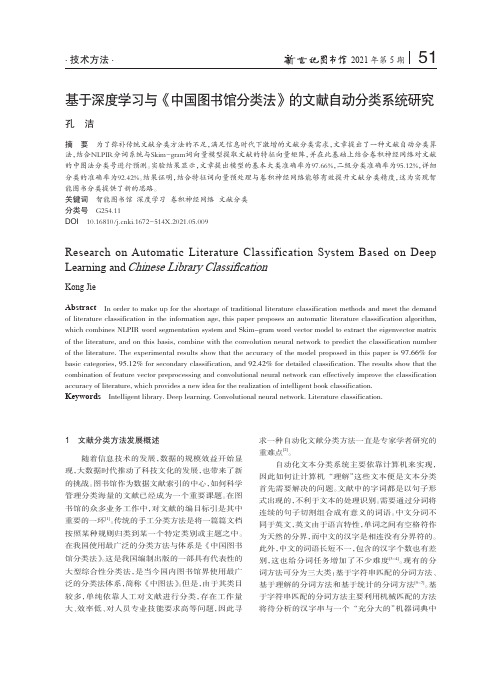
1 文献分类方法发展概述随着信息技术的发展,数据的规模效益开始显现,大数据时代推动了科技文化的发展,也带来了新的挑战。
图书馆作为数据文献索引的中心,如何科学管理分类海量的文献已经成为一个重要课题。
在图书馆的众多业务工作中,对文献的编目标引是其中重要的一环[1]。
传统的手工分类方法是将一篇篇文档按照某种规则归类到某一个特定类别或主题之中。
在我国使用最广泛的分类方法与体系是《中国图书馆分类法》。
这是我国编制出版的一部具有代表性的大型综合性分类法,是当今国内图书馆界使用最广泛的分类法体系,简称《中图法》。
但是,由于其类目较多,单纯依靠人工对文献进行分类,存在工作量大、效率低、对人员专业技能要求高等问题,因此寻求一种自动化文献分类方法一直是专家学者研究的重难点[2]。
自动化文本分类系统主要依靠计算机来实现,因此如何让计算机“理解”这些文本便是文本分类首先需要解决的问题。
文献中的字词都是以句子形式出现的,不利于文本的处理识别。
需要通过分词将连续的句子切割组合成有意义的词语。
中文分词不同于英文,英文由于语言特性,单词之间有空格符作为天然的分界,而中文的汉字是相连没有分界符的。
此外,中文的词语长短不一,包含的汉字个数也有差别,这也给分词任务增加了不少难度[3-4]。
现有的分词方法可分为三大类:基于字符串匹配的分词方法、基于理解的分词方法和基于统计的分词方法[5-7]。
基于字符串匹配的分词方法主要利用机械匹配的方法将待分析的汉字串与一个“充分大的”机器词典中摘 要 为了弥补传统文献分类方法的不足,满足信息时代下激增的文献分类需求,文章提出了一种文献自动分类算法,结合NLPIR分词系统与Skim-gram词向量模型提取文献的特征向量矩阵,并在此基础上结合卷积神经网络对文献的中图法分类号进行预测。
实验结果显示,文章提出模型的基本大类准确率为97.66%,二级分类准确率为95.12%,详细分类的准确率为92.42%。
languagemodelfeaturizer
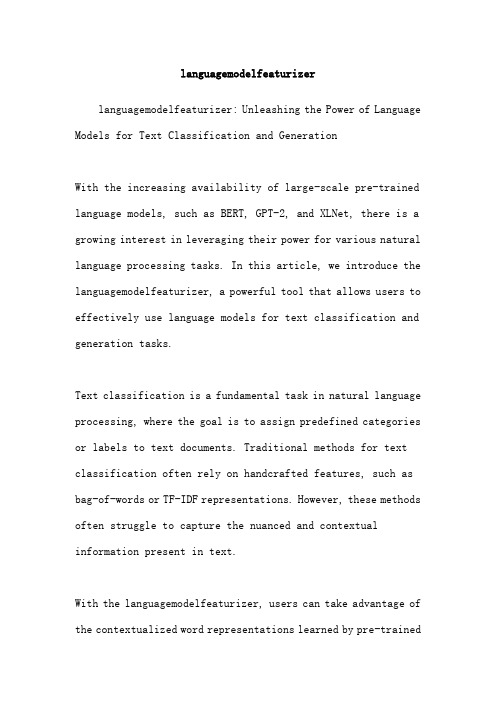
languagemodelfeaturizerlanguagemodelfeaturizer: Unleashing the Power of Language Models for Text Classification and GenerationWith the increasing availability of large-scale pre-trained language models, such as BERT, GPT-2, and XLNet, there is a growing interest in leveraging their power for various natural language processing tasks. In this article, we introduce the languagemodelfeaturizer, a powerful tool that allows users to effectively use language models for text classification and generation tasks.Text classification is a fundamental task in natural language processing, where the goal is to assign predefined categories or labels to text documents. Traditional methods for text classification often rely on handcrafted features, such as bag-of-words or TF-IDF representations. However, these methods often struggle to capture the nuanced and contextual information present in text.With the languagemodelfeaturizer, users can take advantage of the contextualized word representations learned by pre-trainedlanguage models. Instead of relying on fixed, pre-defined features, the languagemodelfeaturizer dynamically computes feature vectors for each word in the input text based on its surrounding context. This allows the model to capture the subtle nuances and contextual information present in the text, resulting in improved text classification performance.Furthermore, the languagemodelfeaturizer can also be used for text generation tasks. Language models have revolutionized the field of text generation by enabling the creation of coherent and contextually relevant text. By feeding in a prompt or a seed text, the languagemodelfeaturizer can generate high-quality text that is consistent with the input.The languagemodelfeaturizer supports a wide range of language models, including both transformer-based models like BERT and GPT-2, as well as other state-of-the-art architectures. It provides a user-friendly interface that allows users to easily integrate language models into their existing text classification and generation pipelines.In addition to its ease of use, the languagemodelfeaturizeralso offers flexibility and scalability. Users can fine-tune the language models on their specific task or domain to further improve performance. The featurizer can handle large amounts of text data efficiently, making it suitable for bothsmall-scale experiments and large-scale production systems.In conclusion, the languagemodelfeaturizer opens up new possibilities for leveraging the power of language models in text classification and generation tasks. By utilizing the contextualized word representations learned by pre-trained models, users can achieve state-of-the-art results and generate high-quality text. Whether you are working on sentiment analysis, topic classification, or text generation, the languagemodelfeaturizer is a powerful tool that can enhance your NLP applications.。
通信特定辐射源识别的多特征融合分类方法
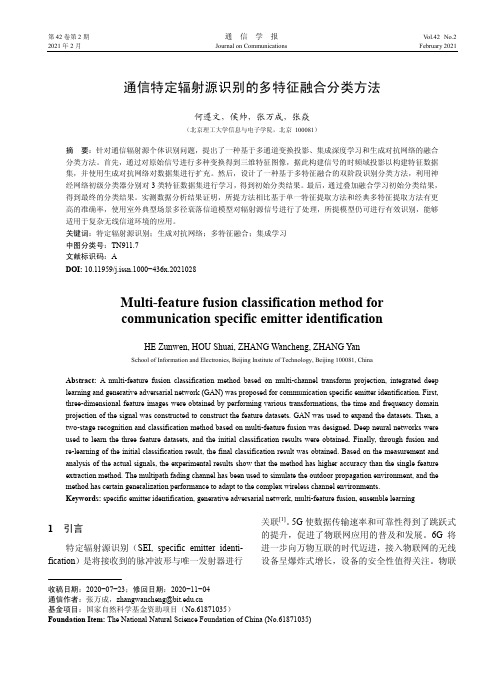
2021年2月Journal on Communications February 2021 第42卷第2期通信学报V ol.42No.2通信特定辐射源识别的多特征融合分类方法何遵文,侯帅,张万成,张焱(北京理工大学信息与电子学院,北京 100081)摘 要:针对通信辐射源个体识别问题,提出了一种基于多通道变换投影、集成深度学习和生成对抗网络的融合分类方法。
首先,通过对原始信号进行多种变换得到三维特征图像,据此构建信号的时频域投影以构建特征数据集,并使用生成对抗网络对数据集进行扩充。
然后,设计了一种基于多特征融合的双阶段识别分类方法,利用神经网络初级分类器分别对3类特征数据集进行学习,得到初始分类结果。
最后,通过叠加融合学习初始分类结果,得到最终的分类结果。
实测数据分析结果证明,所提方法相比基于单一特征提取方法和经典多特征提取方法有更高的准确率,使用室外典型场景多径衰落信道模型对辐射源信号进行了处理,所提模型仍可进行有效识别,能够适用于复杂无线信道环境的应用。
关键词:特定辐射源识别;生成对抗网络;多特征融合;集成学习中图分类号:TN911.7文献标识码:ADOI: 10.11959/j.issn.1000−436x.2021028Multi-feature fusion classification method forcommunication specific emitter identificationHE Zunwen, HOU Shuai, ZHANG Wancheng, ZHANG YanSchool of Information and Electronics, Beijing Institute of Technology, Beijing 100081, China Abstract: A multi-feature fusion classification method based on multi-channel transform projection, integrated deep learning and generative adversarial network (GAN) was proposed for communication specific emitter identification. First, three-dimensional feature images were obtained by performing various transformations, the time and frequency domain projection of the signal was constructed to construct the feature datasets. GAN was used to expand the datasets. Then, a two-stage recognition and classification method based on multi-feature fusion was designed. Deep neural networks were used to learn the three feature datasets, and the initial classification results were obtained. Finally, through fusion and re-learning of the initial classification result, the final classification result was obtained. Based on the measurement and analysis of the actual signals, the experimental results show that the method has higher accuracy than the single feature extraction method. The multipath fading channel has been used to simulate the outdoor propagation environment, and the method has certain generalization performance to adapt to the complex wireless channel environments.Keywords: specific emitter identification, generative adversarial network, multi-feature fusion, ensemble learning1 引言特定辐射源识别(SEI, specific emitter identi-fication)是将接收到的脉冲波形与唯一发射器进行关联[1]。
大连理工大学硕士学位论文中文情感词汇本体的构建及其应用姓名
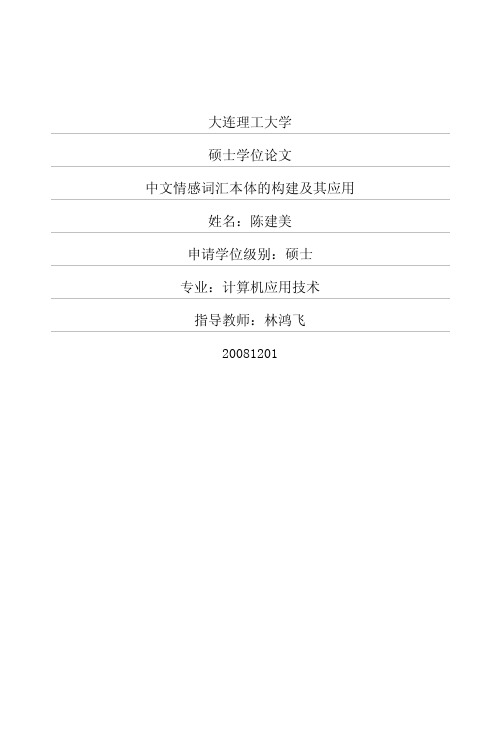
作者签名: 导师签名:
日期:4理工大学学位论文独创性声明
作者郑重声明:所呈交的学位论文,是本人在导师的指导下进行研究 工作所取得的成果。尽我所知,除文中已经注明引用内容和致谢的地方外, 本论文不包含其他个人或集体已经发表的研究成果,也不包含其他已申请 学位或其他用途使用过的成果。与我一同工作的同志对本研究所做的贡献 均已在论文中做了明确的说明并表示了谢意。 若有不实之处,本人愿意承担相关法律责任。 学位论文题目: 作者签名:
rules,analyzed
the result strictly,and found the main
reasons
of some mistakes.
In the processing of muRi—affective words construction,we used the semi-automatic ways.
needed
be disambiguation in word affective
certain context.We
disambiguation.
think
differences are
useful
for the
further
In the word affective disambiguation part,we analyzed the difference and resemblance
method of automatic emotion
as
vocabulary
acquisition based
on
CRF.In the experiment,we used some rules,such
the
山东科技大学硕士学位论文Chap...
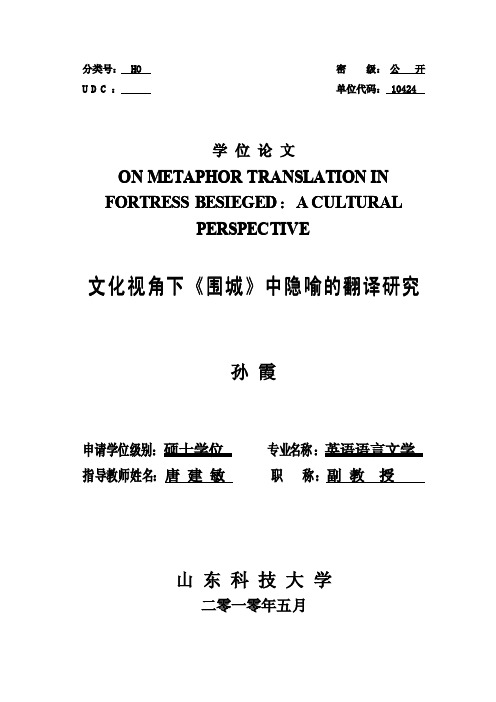
分类号:HO密级:公开U D C:单位代码:10424学位论文O N METAPHOR T RANSLATION INFORTRESS BESIEGED:A CULTURALPERSPECTIVE文化视角下《围城》中隐喻的翻译研究孙霞申请学位级别:硕士学位专业名称:英语语言文学指导教师姓名:唐建敏职称:副教授山东科技大学二零一零年五月论文题目:文化视角下《围城》中隐喻的翻译研究作者姓名:孙霞入学时间:2008年9月专业名称:英语语言文学研究方向:外国语言学与应用语言学指导教师:唐建敏职称:副教授论文提交日期:2010年4月论文答辩日期:2010年6月授予学位日期:ON METAPHOR TRANSALTION IN FORTRESS BESIEGED:A CULTURAL PERSPECTIVEA thesis submitted in partial fulfillment of the requirements of the degree ofMASTER OF ARTSfromShandong University of Science and TechnologybySun XiaSupervisor:Associate Professor Tang JianminCollege of Foreign LanguagesApril20201010声明本人呈交给山东科技大学的这篇硕士学位论文,除了所列参考文献和世所公认的文献外,全部是本人在导师指导下的研究成果。
该论文资料尚没有呈交于其它任何学术机关作鉴定。
硕士生签名:日期:AFFIRMATIONI declare that this thesis,submitted in partial fulfillment of the requirements for the award of Master of Arts in Shandong University of Science andTechnology,is wholly my own work unless referenced of acknowledge acknowledgement ment ment..The document has not been submitted for qualification at any other academic institute.Signature:Date:摘要英国修辞学家理查兹认为,日常会话中几乎每三句话就可能有一个隐喻;皮特·纽马克也认为英语中四分之三的语言是隐喻。
高中新教材英语课件选择性必修第一册Body LanguagSectionⅣWriting

compound sentences, etc., to enhance the richness and accuracy
of language expression.
03
Rhetorical devices
Using metaphors, personification, and other rhetorical devices
related to body language, such as structure, social expression,
and post.
02
Sentence features
Using multiple sentence structures, including simple sentences,
Revision and polishing
Revise and polish the initial draft, check grammar, spelling, and other errors to ensure the quality of the article.
Writing precautions
Teaching Focus and Difficulties
Teaching focus
Guide students to think deeply about body language and learn to express their opinions and opinions in English; Assist students in mastering vocabulary and expressions related to body language.
基于领域知识库的水生生物领域文献检索分类技术研究
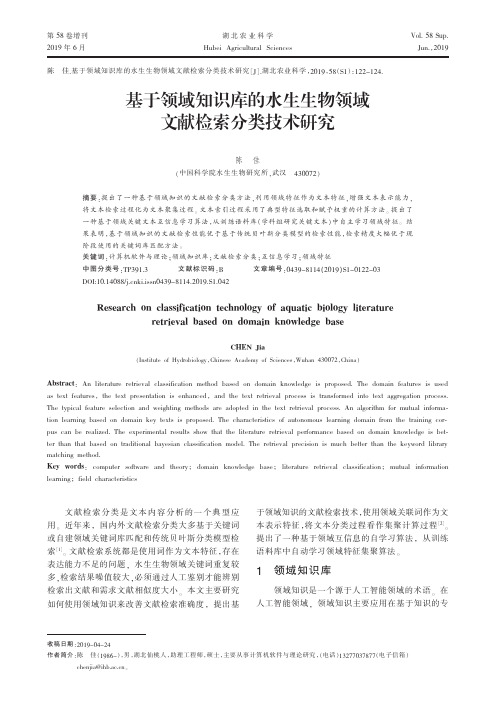
DOI:10.14088/ki.issn0439-8114.2019.S1.042
Research on classification technology of aquatic biology literature retrieval based on domain knowledge base
果表明,基于领域知识的文献检索性能优于基于传统贝叶斯分类模型的检索性能,检索精度大幅优于现
阶段使用的关键词库匹配方法。
关键词:计算机软件与理论;领域知识库;文献检索分类;互信息学习;领域特征
中 图 分 类 号 :TP391.3
文 献 标 码 :B
文 章 编 号 :0439-8114(2019)S1-0122-03
于领域知识的文献检索技术,使用领域关联词作为文 本 表 示 特 征 ,将 文 本 分 类 过 程 看 作 集 聚 计 算 过 程 [2]。 提出了一种基于领域互信息的自学习算法, 从训练 语料库中自动学习领域特征集聚算法。
1 领域知识库
领域知识是一个源于人工智能领域的术语。 在 人工智能领域, 领域知识主要应用在基于知识的专
现阶段已经历系统开发的领域词典中包含了 50 多万条词条,1 100 多个领域特征, 涉及 40 多个 领域,全部根据真实语料,首先进行人工分类,然后 采用机器辅助人工校对的方法构造的领域词典中主 要包含 3 类信息:领域关联词、领域特征和领域属 性[3]。 例如领域关联词“鱼类、藻类、鲸类”的领域特 征 为 “ 生 物 ”, 领 域 属 性 为 “ 水 生 生 物 ”; 领 域 关 联 词 “淡水鱼类”的领域特征为“淡水生物”,领域属性为 “鱼类”。 试验显示充分利用传统语法语义知识和领 域知识是一种提高检索精确度的有效途径。
基于BERT模型与知识蒸馏的意图分类方法
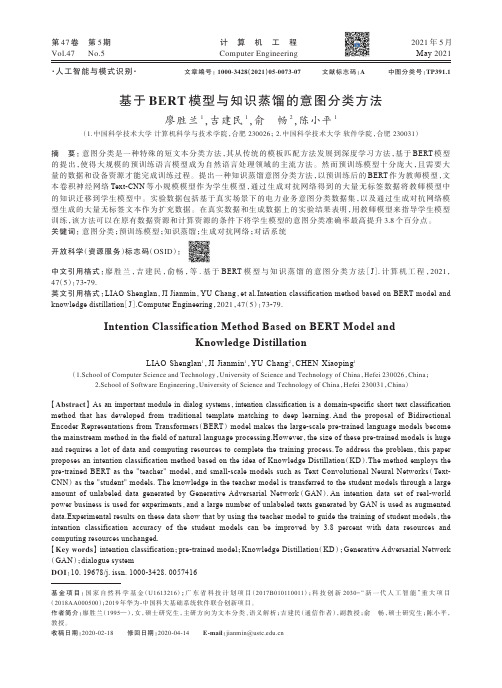
第47卷第5期Vol.47No.5计算机工程Computer Engineering2021年5月May 2021基于BERT 模型与知识蒸馏的意图分类方法廖胜兰1,吉建民1,俞畅2,陈小平1(1.中国科学技术大学计算机科学与技术学院,合肥230026;2.中国科学技术大学软件学院,合肥230031)摘要:意图分类是一种特殊的短文本分类方法,其从传统的模板匹配方法发展到深度学习方法,基于BERT 模型的提出,使得大规模的预训练语言模型成为自然语言处理领域的主流方法。
然而预训练模型十分庞大,且需要大量的数据和设备资源才能完成训练过程。
提出一种知识蒸馏意图分类方法,以预训练后的BERT 作为教师模型,文本卷积神经网络Text-CNN 等小规模模型作为学生模型,通过生成对抗网络得到的大量无标签数据将教师模型中的知识迁移到学生模型中。
实验数据包括基于真实场景下的电力业务意图分类数据集,以及通过生成对抗网络模型生成的大量无标签文本作为扩充数据。
在真实数据和生成数据上的实验结果表明,用教师模型来指导学生模型训练,该方法可以在原有数据资源和计算资源的条件下将学生模型的意图分类准确率最高提升3.8个百分点。
关键词:意图分类;预训练模型;知识蒸馏;生成对抗网络;对话系统开放科学(资源服务)标志码(OSID ):中文引用格式:廖胜兰,吉建民,俞畅,等.基于BERT 模型与知识蒸馏的意图分类方法[J ].计算机工程,2021,47(5):73-79.英文引用格式:LIAO Shenglan ,JI Jianmin ,YU Chang ,et al.Intention classification method based on BERT model and knowledge distillation [J ].Computer Engineering ,2021,47(5):73-79.Intention Classification Method Based on BERT Model andKnowledge DistillationLIAO Shenglan 1,JI Jianmin 1,YU Chang 2,CHEN Xiaoping 1(1.School of Computer Science and Technology ,University of Science and Technology of China ,Hefei 230026,China ;2.School of Software Engineering ,University of Science and Technology of China ,Hefei 230031,China )【Abstract 】As an important module in dialog systems ,intention classification is a domain-specific short text classificationmethod that has developed from traditional template matching to deep learning.And the proposal of Bidirectional Encoder Representations from Transformers (BERT )model makes the large-scale pre-trained language models become the mainstream method in the field of natural language processing.However ,the size of these pre-trained models is huge and requires a lot of data and computing resources to complete the training process.To address the problem ,this paper proposes an intention classification method based on the idea of Knowledge Distillation (KD ).The method employs the pre-trained BERT as the "teacher"model ,and small-scale models such as Text Convolutional Neural Networks (Text-CNN )as the "student"models.The knowledge in the teacher model is transferred to the student models through a large amount of unlabeled data generated by Generative Adversarial Network (GAN ).An intention data set of real-world power business is used for experiments ,and a large number of unlabeled texts generated by GAN is used as augmented data.Experimental results on these data show that by using the teacher model to guide the training of student models ,the intention classification accuracy of the student models can be improved by 3.8percent with data resources and computing resources unchanged.【Key words 】intention classification ;pre-trained model ;Knowledge Distillation (KD);Generative Adversarial Network (GAN );dialogue system DOI :10.19678/j.issn.1000-3428.0057416基金项目:国家自然科学基金(U1613216);广东省科技计划项目(2017B010110011);科技创新2030-“新一代人工智能”重大项目(2018AA000500);2019年华为-中国科大基础系统软件联合创新项目。
英语作文中如何分类阅读
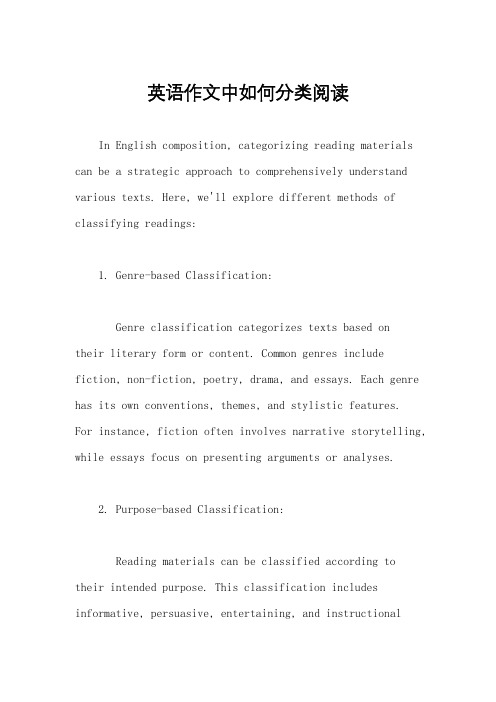
英语作文中如何分类阅读In English composition, categorizing reading materials can be a strategic approach to comprehensively understand various texts. Here, we'll explore different methods of classifying readings:1. Genre-based Classification:Genre classification categorizes texts based ontheir literary form or content. Common genres include fiction, non-fiction, poetry, drama, and essays. Each genre has its own conventions, themes, and stylistic features.For instance, fiction often involves narrative storytelling, while essays focus on presenting arguments or analyses.2. Purpose-based Classification:Reading materials can be classified according totheir intended purpose. This classification includes informative, persuasive, entertaining, and instructionaltexts. Informative texts aim to convey facts or knowledge, while persuasive texts seek to convince the reader of a particular viewpoint. Entertainment texts focus on providing enjoyment or amusement, while instructional texts offer guidance or directions.3. Content-based Classification:Content-based classification categorizes readings based on their subject matter. This classification includes topics such as history, science, literature, philosophy, technology, and more. Each category encompasses a wide range of texts that explore different aspects of the respective subject.4. Audience-based Classification:Audience-based classification considers the intended audience for the reading material. Texts can be classified as children's literature, young adult literature, adult literature, academic texts, professional texts, etc. The language, content complexity, and themes of the text areoften tailored to suit the target audience.5. Complexity-based Classification:Reading materials can be classified based on their complexity level, which includes beginner, intermediate, and advanced levels. This classification helps readers select texts that match their reading proficiency and challenge themselves appropriately. Textbooks, scholarly articles, and literary classics are examples of materials that vary in complexity.6. Temporal-based Classification:Temporal-based classification categorizes readings based on their historical or temporal context. Texts can be classified as contemporary, historical, classical, or futuristic. Understanding the temporal context of a text is crucial for interpreting its themes, language, and relevance to specific time periods.7. Cultural-based Classification:Cultural-based classification considers the cultural context of the reading material. Texts can be classified as multicultural, indigenous, Western, Eastern, etc., based on the cultural perspectives they represent or address. This classification helps readers explore diverse cultural experiences and perspectives.In conclusion, classifying readings based on genre, purpose, content, audience, complexity, temporal context, and cultural context provides readers with a structured approach to engage with various types of texts. By understanding the different classifications, readers can enhance their reading comprehension and critical analysis skills across a wide range of literary works.。
一种基于情感词典和朴素贝叶斯的中文文本情感分类方法_杨鼎

收稿日期:2010-03-11;修回日期:2010-04-21基金项目:湖南省教育厅科学研究资助项目(07B014);广东省自然科学基金资助项目(9151805707000010);广州市社科规划项目(08Y59)作者简介:杨鼎(1982-),男,河南禹州人,硕士,主要研究方向为文本情感分类、数据挖掘(dean@hut.edu.cn );阳爱民(1970-),男,湖南永州人,教授,博士,主要研究方向为模式分类、智能计算.一种基于情感词典和朴素贝叶斯的中文文本情感分类方法*杨鼎1,2,阳爱民1,3(1.湖南工业大学计算机与通信学院,湖南株洲412008;2.湖南省教育考试院信息处,长沙410001;3.广东外语外贸大学信息科学与技术学院,广州510006)摘要:基于朴素贝叶斯理论提出了一种新的中文文本情感分类方法。
这种方法利用情感词典对文本进行处理和表示,基于朴素贝叶斯理论构建文本情感分类器,并以互联网上宾馆中文评论作为分类研究的对象。
实验表明,使用提出的方法构成的分类器具有分类速度快、分类准确度高、鲁棒性强等特点,并且适合于大量中文文本情感分类应用系统。
关键词:文本情感分类;朴素贝叶斯;情感词典中图分类号:TP391文献标志码:A文章编号:1001-3695(2010)10-3737-03doi :10.3969/j.issn.1001-3695.2010.10.035Classification approach of Chinese texts sentiment based onsemantic lexicon and naive BayesianYANG Ding 1,2,YANG Ai-min 1,3(1.Institute of Computer &Communication ,Hunan University of Technology ,Zhuzhou Hunan 412008,China ;2.Dept.of Information ,Hu-nan Provincial Education Examination Board ,Changsha 410001,China ;3.School of Informatics ,Guangdong University of Foreign Studies ,Guangzhou 510006,China )Abstract :This paper provided a new classification approach of Chinese texts based on naive Bayesian.The approach reachedits goal by applying semantic lexicon on text processing and expressing ,constructing sentiment classifier based on naive Bayes-ian and experimental data obtained from hotel ’s Chinese reviews through Internet service.Backed with the experimental data ,this approach demonstrates its efficiency ,accuracy and robustness ,which makes it applicable as well in sentiment classifica-tion for plenty of Chinese texts.Key words :text sentiment classification ;naive Bayesian ;semantic lexicon人们对事物的情感都是有两面性的,如正面与反面、褒义与贬义等。
informative text type例子
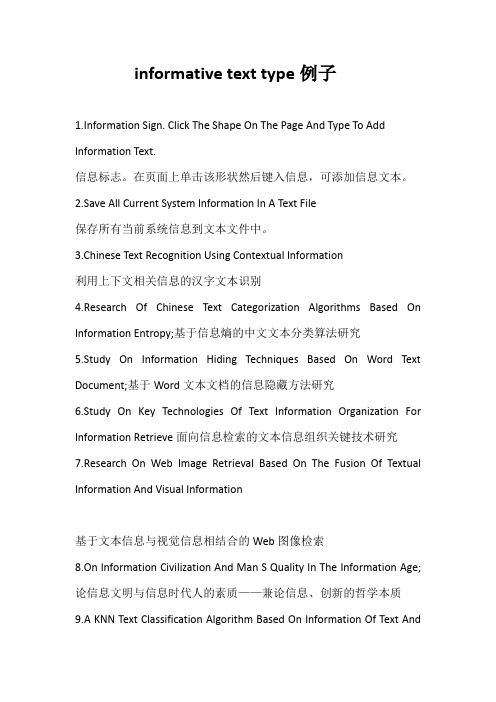
informative text type例子rmation Sign. Click The Shape On The Page And Type To Add Information Text.信息标志。
在页面上单击该形状然后键入信息,可添加信息文本。
2.Save All Current System Information In A Text File保存所有当前系统信息到文本文件中。
3.Chinese Text Recognition Using Contextual Information利用上下文相关信息的汉字文本识别4.Research Of Chinese Text Categorization Algorithms Based On Information Entropy;基于信息熵的中文文本分类算法研究5.Study On Information Hiding Techniques Based On Word Text Document;基于Word文本文档的信息隐藏方法研究6.Study On Key Technologies Of Text Information Organization For Information Retrieve面向信息检索的文本信息组织关键技术研究7.Research On Web Image Retrieval Based On The Fusion Of Textual Information And Visual Information基于文本信息与视觉信息相结合的Web图像检索8.On Information Civilization And Man S Quality In The Information Age;论信息文明与信息时代人的素质——兼论信息、创新的哲学本质9.A KNN Text Classification Algorithm Based On Information Of Text AndSorts基于文本和类别信息的KNN文本分类算法10.Steganalysis For Stegotext Based On Text Redundancy基于文本剩余度的文本隐藏信息检测方法研究11.// WARNING: The Information In This File Is Protected By Copyright Law ////警告:本文件中的信息受版权法//12.This Passage Dose Not Contain Enough Information For You To Do First Aid Correctly!本文并不包含正确急救的全部信息。
